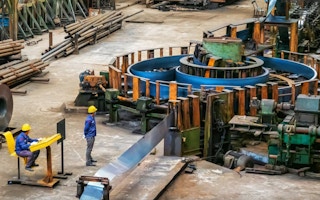A new report by think tank Institute for Democracy and Economic Affairs (IDEAS) proposes carbon pricing as a viable solution for the Malaysian steel industry to cut greenhouse gas (GHG) emissions, as steel production booms in the country.
The steel industry accounts for about 8 per cent of global GHG emissions annually. Though the industry has been pivoting towards lower-carbon production methods such as electric arc furnace (EAF) technology, the growth of the Malaysian steel industry has largely been based on highly polluting coal-based Blast Furnace-Basic Oxygen Furnace (BF-BOF) technology, the report finds.
“Malaysia’s steel sector has moved from a lower-than-average carbon intensity to higher than the world’s average,” said report co-author Dr Renato Lima, a research affiliate at the Massachusetts Institute of Technology (MIT), and a senior fellow at IDEAS Malaysia.
The report also shows that carbon-heavy steel production in Malaysia is chiefly driven by foreign investments from China. The construction of new China-backed blast furnace steel mills has exacerbated overcapacity concerns in Malaysia as well as in Southeast Asia.

Malaysia’s steel production has grown by 69 per cent (+2.84 megatonnes) between 2018 and 2019, following the start of steel production by China’s Alliance Steel from late 2017. Alliance Steel has a production capacity of 3.5 megatonnes per annum. Image: IDEAS report
“Chinese steel producers have been increasing their investments in Asean due to excess capacity and falling demand in China. The increasing cost of environmental regulation and taxes, and restrictions on new steel investment in China have also made Asean countries more attractive due to the region’s less stringent environmental regulations,” the report said.
Malaysia’s steel production capacity is projected to grow faster than anywhere in Southeast Asia, rising by 32.8 million tonnes per year (Mtpa) from 16.1Mtpa in 2023 to 48.9Mtpa by 2030 – a more than 200 per cent increase, according to the South East Asia Iron and Steel Institute.
Data from the Malaysian Steel Institute (MSI) shows that GHG emissions from steel production reached 12,228 gigagram of carbon dioxide equivalent (GgCO2e) in 2019, a 370 per cent spike from the 2,593GgCO2e in 2011.
The rapid expansion of blast furnace steel mills in Malaysia is projected to increase emissions to 38,695GgCO2e by 2030, accounting for about 12 per cent of national GHG emissions.

The rapid expansion of blast furnace steel mills in Malaysia is projected to increase emissions to 38,695GgCO2e by 2030, accounting for about 12 per cent of national GHG emissions. Image: IDEAS report
To cut the alarming rate of emissions growth and transition towards low-carbon steel production, IDEAS recommends carbon pricing — through a carbon tax and cap-and-trade system — along with the implementation of a Carbon Border Adjustment Mechanism (CBAM)-like carbon import tax to avoid leakages and to protect Malaysian producers from foreign producers that are not subjected to taxes.
Malaysia currently does not have a carbon pricing framework or binding laws on climate change or decarbonisation, which poses a direct challenge for the government to address GHG emissions effectively nationwide, including in the steel sector.
“While carbon pricing is referenced in the Twelfth Malaysia Plan (12MP) 2021-2025, immediate implementation plans are lacking. The National Energy Transition Roadmap (NETR) and the New Industrial Master Plan (NIMP) 2030 outline policies aimed at reducing GHG emissions but they lack specifics on carbon pricing.”
“Instead, temporary indirect control measures, such as a moratorium on new manufacturing capacity imposed by the Ministry of Investment, Trade and Industry (MITI) in 2023 have been introduced to mitigate emissions,” the report said, suggesting that putting a price on carbon can reduce emissions, as it “forces economic actors to internalise the cost of their actions and technological choices.”
“A carbon tax directly sets a price on carbon by levying a fee on GHG emissions, charged by a given government. The tax creates an incentive for companies to reduce emissions to avoid paying the tax, although the exact reduction will depend on the response of firms to the carbon price.”
Several economies around the world have implemented, or are planning to implement carbon pricing for the steel industry, including the European Union in 2005, South Korea in 2015, India after 2024 and China from 2025.
IDEAS is calling for proactive measures from the Malaysian government to address issues of overcapacity in steel production due to rising GHG emissions from the industry.










